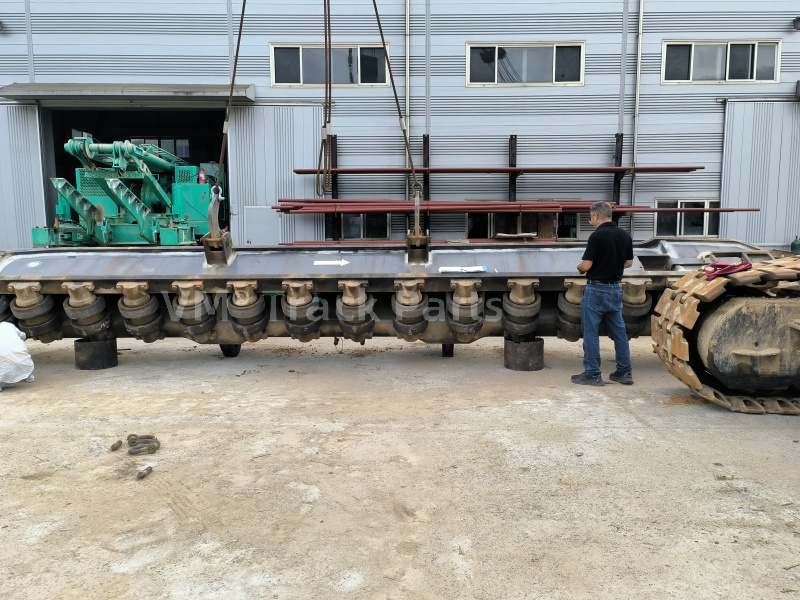
There may be many reasons for crane bottom roller damage, which are mainly related to the working environment, usage load, maintenance and design factors.
Reasons for crane bottom roller damage
1. Overload operation
Overload operation is one of the main reasons for crane bottom roller damage. If the crane works under conditions exceeding the design load, the rollers will need to withstand excessive pressure and are prone to deformation, increased wear, or even breakage.
2. Long-term high-intensity work
Under long-term high-intensity working conditions, the crane bottom roller rollers may suffer from surface wear, cracks and other problems due to continuous friction and pressure, and eventually cause damage.
3. Uneven ground or working environment
When a crane is operating on rough, muddy or uneven ground, the rollers may be subject to uneven force distribution, causing excessive wear or damage. Uneven ground may also accelerate the wear of the rollers.
4. Lack of lubrication or poor lubrication
The friction between the crane bottom rollers and the track requires regular lubrication. If there is insufficient lubrication or poor-quality lubricating oil, the friction coefficient increases. This can lead to excessive wear, overheating of the crane track roller, and eventually cause damage to the crane bottom rollers.
5. The rim does not match the track
If the rim of the crane track roller is misaligned or mismatched with the track, uneven contact between the rim and the track will easily lead to local wear or stress concentration, which may lead to damage.
6. Material quality issues
Poor quality of the crane track roller material is an important reason for crane bottom roller damage, which directly affects its durability. If the crane bottom roller material does not meet the standards or there are manufacturing defects, it is easy to crack, deform or wear out too quickly.
7. Long-term lack of maintenance and inspection
If the crane bottom rollers are not inspected, maintained, or replaced regularly, their wear may go undetected, leading to early damage. The long-term lack of maintenance can exacerbate problems, increase wear, and significantly raise the risk of failure, contributing to crane bottom roller damage.
8. Environmental factors
In hot, cold, humid or corrosive environments, crane bottom rollers can be subject to additional stress and damage. For example, moisture can cause corrosion, cold weather can cause materials to become brittle, and so on.
9. Improper operation
Improper crane operation, such as sudden acceleration, sharp turns, frequent emergency stops, etc., will increase the wear of the crane bottom rollers. Operators need to receive professional training to avoid excessive wear on the rollers.
10. Aging and material fatigue
Over time, the material of the crane track roller may fatigue due to repeated loads and long-term use, resulting in a reduction in strength and problems such as cracks or breaks.
11. Improper installation
If the rollers are installed improperly, such as at wrong installation angles or loose bolts, it may cause uneven contact between the wheels and the track, increase wear or cause damage.
12. External shock or accident
During transportation and operation, if the rollers encounter external impacts (such as hitting obstacles, etc.), the crane bottom rollers may be damaged or deformed.

VM® bottom roller:
1. High-strength materials
High-strength alloy steel or other high-performance materials are used to improve the pressure resistance and wear resistance of the rollers, ensuring that they are not easily damaged during long-term use under high-load working conditions.
The use of corrosion-resistant materials can effectively cope with harsh working environments, prevent rust and corrosion, and increase service life.
2. Precision machining technology
Through precision casting and machining technology, the dimensional accuracy and surface smoothness of the crane bottom rollers are ensured, making their contact with the rails more uniform, reducing wear and failure.
High-quality heat treatment processes (such as quenching, tempering, etc.) enhance the hardness and durability of the crane track rollers and reduce the risk of fatigue damage.
3. High-temperature and cold-resistant performance
High-quality materials and processing technology enable the rollers to have strong high-temperature and low-temperature resistance, adapt to various extreme climate environments, and ensure stable operation of the equipment.
The crane track rollers can still maintain good toughness and durability in extremely cold or high-temperature environments, reducing performance degradation caused by environmental changes.





